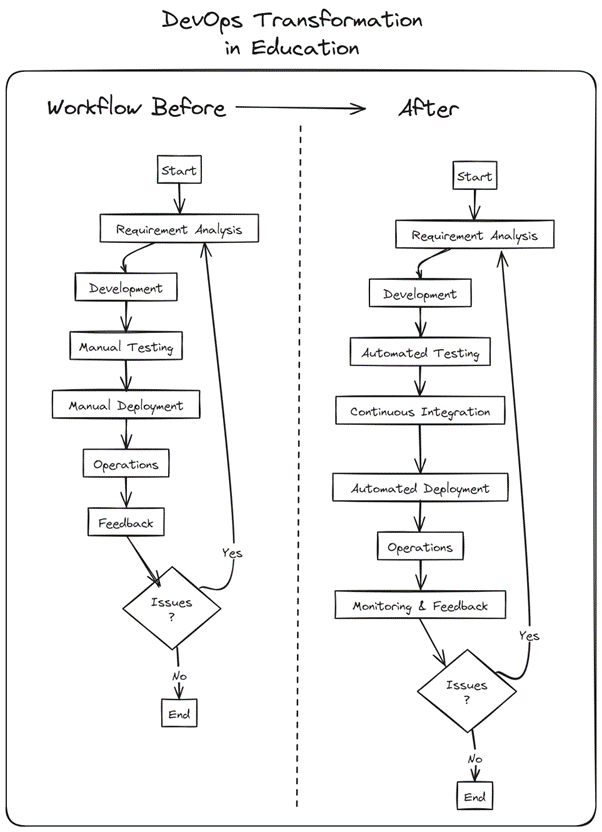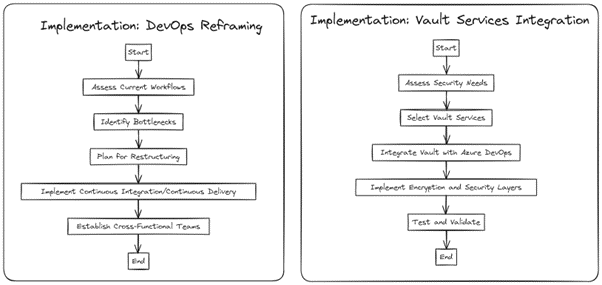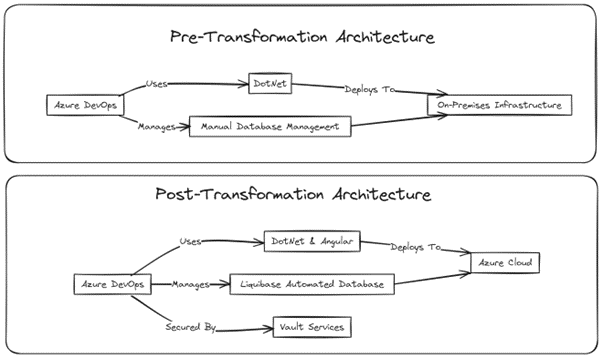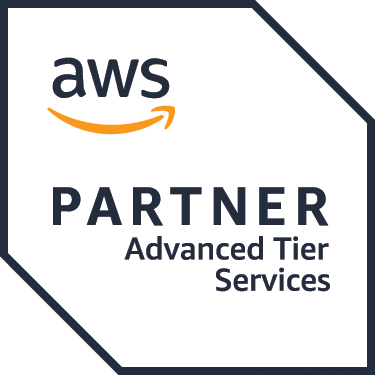Transforming Education Through DevOps Innovation
Executive Summary
The Education Department in the US embarked on a strategic DevOps transformation to address inefficiencies in software delivery, security vulnerabilities, and collaboration gaps among teams. This case study outlines the challenges faced, the DevOps solutions implemented, and the significant results achieved.
Company Overview
The Department of Education manages public education funding and oversees a variety of databases and applications for schools across the state. Utilizing a suite of technologies including Azure DevOps, Liquibase, Azure Cloud, DotNet, and Angular, the department is dedicated to enhancing educational delivery and outcomes through technology.
Challenges Faced
- Delays in software delivery due to inefficient release cycles
- Security vulnerabilities, particularly in credential management
- Poor collaboration among development, operations, and security teams
- Manual errors in database management
- Elevated costs and maintenance demands of on-premises infrastructure
Solutions Implemented
- Adopted best practices and restructured the DevOps organization for better workflow assessments, continuous integration/delivery, and cross-functional collaboration.
- Integrated Vault Services with Azure DevOps for improved credential management and security.
- Implemented a robust branching strategy and established best practices for pull requests, including code reviews and automated testing.
- Automated database management processes with Liquibase, enhancing traceability and reducing manual errors.
- Developed comprehensive documentation and presentations to outline the new DevOps architecture.
- Migrated from on-premises deployments to Azure Cloud, streamlining processes and reducing infrastructure costs.
Workflow Optimization Process
- • Evolved from manual, siloed processes to an automated, collaborative approach incorporating Automated Testing, Continuous Integration, and Automated Deployment. This significantly reduced release cycles and manual errors.

DevOps Implementation Process
- Undertook DevOps reframing by assessing current workflows and identifying bottlenecks. This led to restructuring and the establishment of cross-functional teams, as well as the integration of Vault services into the Azure DevOps environment for enhanced security.

Solution Architecture Diagrams
- Before DevOps transformation, the solution architecture showed the reliance on Azure DevOps with DotNet, manual database management, and on-premises infrastructure, indicating the areas that contributed to inefficiencies and high maintenance costs.
- Post-transformation, the new, more efficient technical setup was implemented at NDE. It includes Azure DevOps with enhanced tools like DotNet, Angular, Liquibase, and Azure Cloud, along with the integration of Vault Services, reflecting the improvements in scalability, security, and cost efficiency as discussed in the case study.

Results and Impact
- Achieved a 30% reduction in release cycles
- Improved secure credential management by 25%
- Fostered enhanced collaboration among teams
- Reduced manual database errors by 35%
- Decreased downtime by 20% and improved scalability
- Lowered infrastructure costs by 25%
Testimonial
“Implementing new DevOps practices and technologies has led to remarkable improvements in our operations. Faster release cycles, better collaboration, and increased confidence in application security and reliability have enhanced our technical capabilities, allowing us to focus more effectively on our primary goal of providing quality education.” — Department of Education
Future Plans
- Enhance capabilities with advanced analytics and AI
- Expand cloud services for greater scalability and efficiency
- Upgrade cybersecurity measures to protect sensitive data
- Broaden the use of Agile methodologies across departments
- Develop customized applications to meet unique educational needs
- Promote the use of collaborative tools among students, teachers, and administrators
- Invest in continuous learning and development for IT staff
Conclusion
The Department’s DevOps transformation exemplifies a commitment to leveraging technology for educational innovation and improvement. By addressing critical challenges with strategic solutions, the department has positioned itself for future advancements in both technology and education administration.






